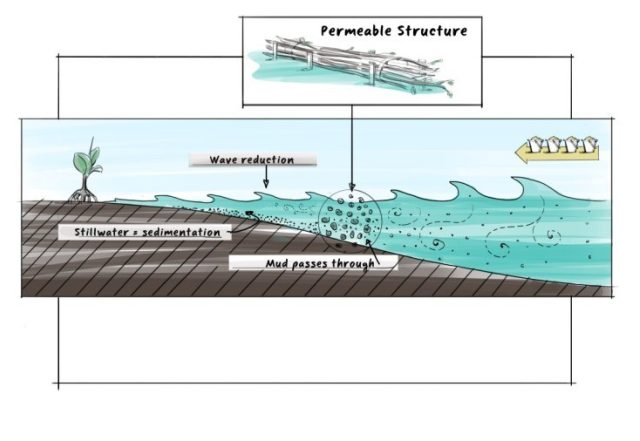Mangrove coasts under threat
Mangroves, found worldwide in the tropics and subtropics, are disappearing at a rapid pace. This is mainly caused by anthropogenic pressures, such as land clearing for urban development or for establishment of fish and shrimp ponds in more rural areas. Additionally, construction of infrastructure, canalisation of rivers and extraction of ground water are disrupting fresh water and sediment flows thereby exacerbating coastal erosion and subsidence. This results not only in loss of mangroves, but also in loss of infrastructure, houses and valuable land.

The traditional response for mitigation of coastal erosion is the construction of seawalls and break waters. However, in areas with soft muddy substrates, hard structures only enhance erosion and often collapse, requiring enormous construction and maintenance budgets.
New techniques for mangrove restoration
Deltares develops alternative measures that focus on restoration of system dynamics, such as the construction of permeable dams that mimic the natural functions of mangroves to dissipate waves and thereby enable natural mangrove regeneration to occur.
Accretion and compaction of sediments occurs behind the dams, leading to a more stable bed which can continue accreting to keep up with sea level rise, unlike the static protection offered by hard structures.

These measures are based on state of the art knowledge of the physical and ecological system. Deltares advocates restoration techniques that adhere to the principles of restoration ecology and Ecological Mangrove Restoration (EMR).
A mangrove forest not only offers coastal protection but in addition ecosystem services provided by healthy mangrove forests, such as enhanced fisheries and shellfish benefits but also the making of krupuk, paint and syrup, can contribute to the socio-economic prosperity of the surrounding communities.
Working towards integrating design
Although mangroves are effective for dissipation of waves and trapping of sediment, they will not provide complete protection in areas prone to coastal flooding. In these areas, a mangrove greenbelt should be combined with a levee or dam structure. Deltares is working towards integrating design of earthen dams and levees with mangroves. This ensures the wave attenuation capacity of the mangrove will be taken into account to develop a robust levee design for muddy systems.
In order to determine optimal width of the mangrove forest, ecological stability and resilience of the forest will also be considered. For a multi-functional and sustainable coastal defence system sufficient space is needed to allow for natural dynamics such as accretion and erosion processes on the mangrove edge.
Integrating innovative solutions in large-scale and long-term planning
We are currently testing the effectiveness of bamboo permeable dams along the North coast of Java (Indonesia). This work is conducted under the Ecoshape Building with Nature program in collaboration with Wetlands International, IMARES/WUR, Witteveen and Bos and local government parties, such as the Indonesian Ministry of Marine Affairs and Fisheries (KKP) and the Indonesian Ministry of Public Works (PU).
With its long standing knowledge in coastal and river management, Deltares is able to integrate and evaluate new intervention strategies against the full suite of measures, ranging from traditional engineering to ecosystem-based interventions. Modelling and assessment tools, developed in-house, allow for the evaluation of performance of measures under uncertain future scenarios, related to climate change and on-going subsidence.


